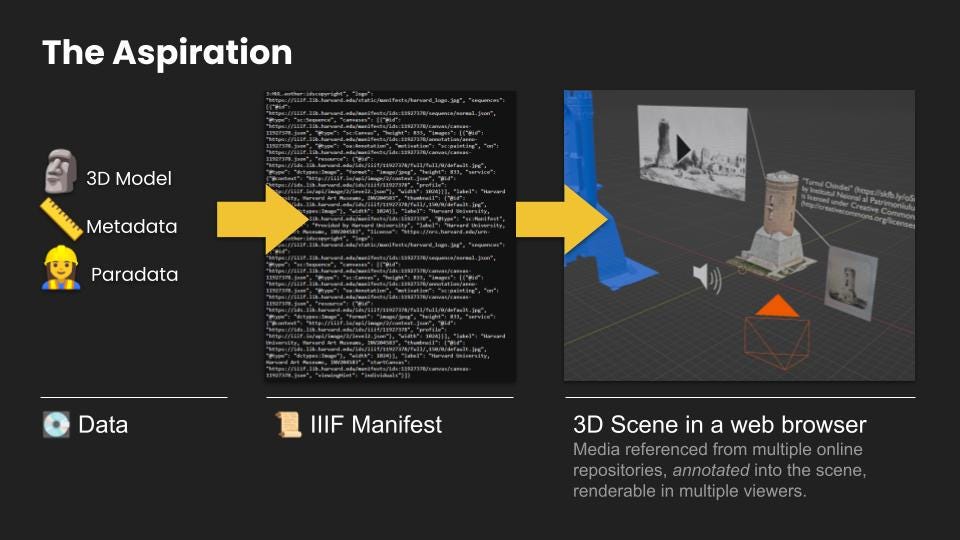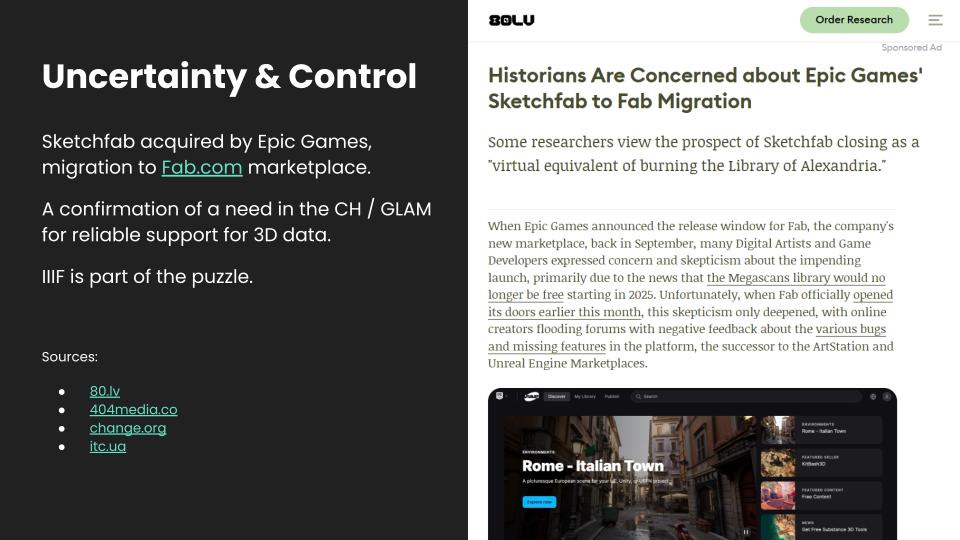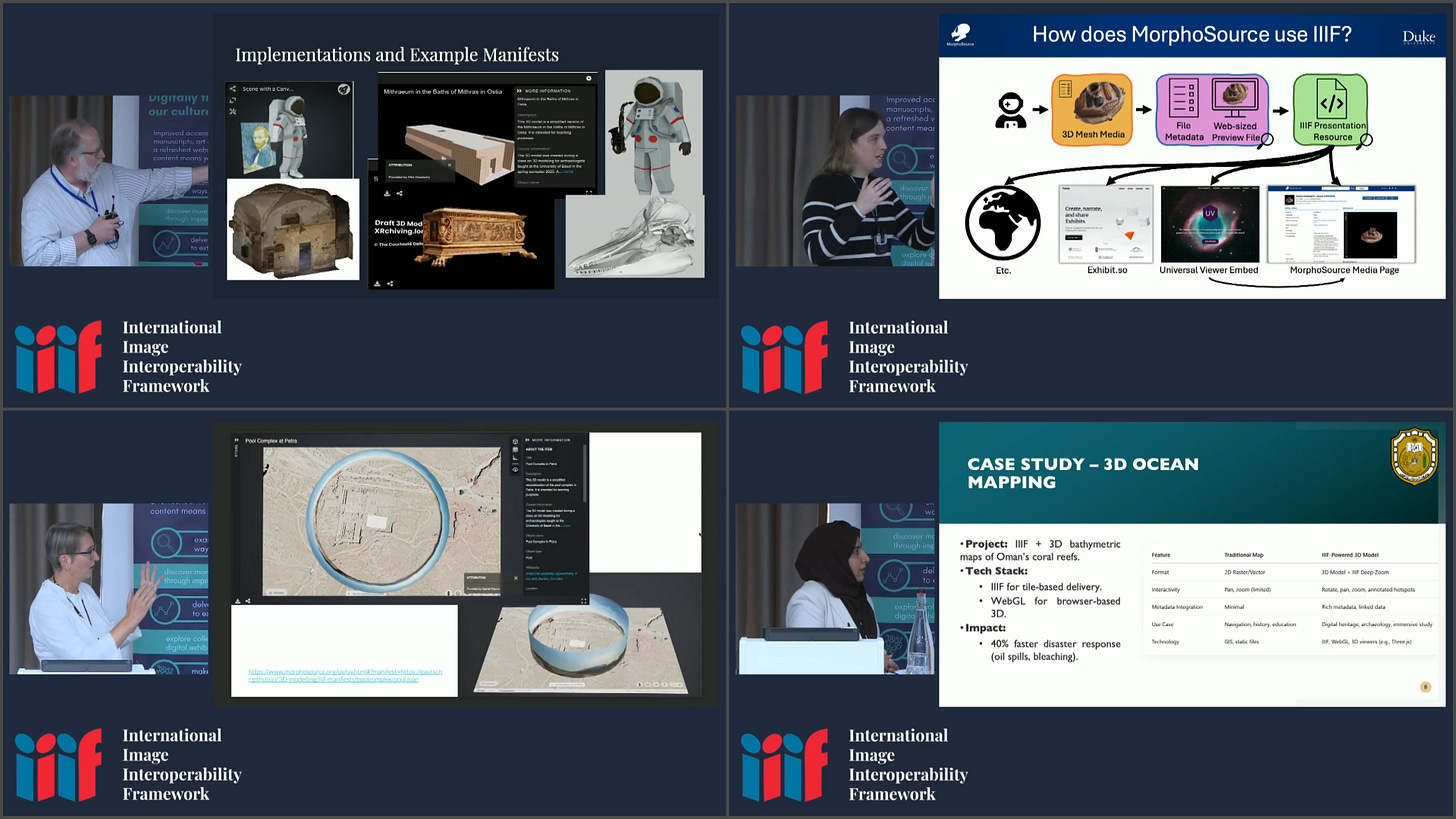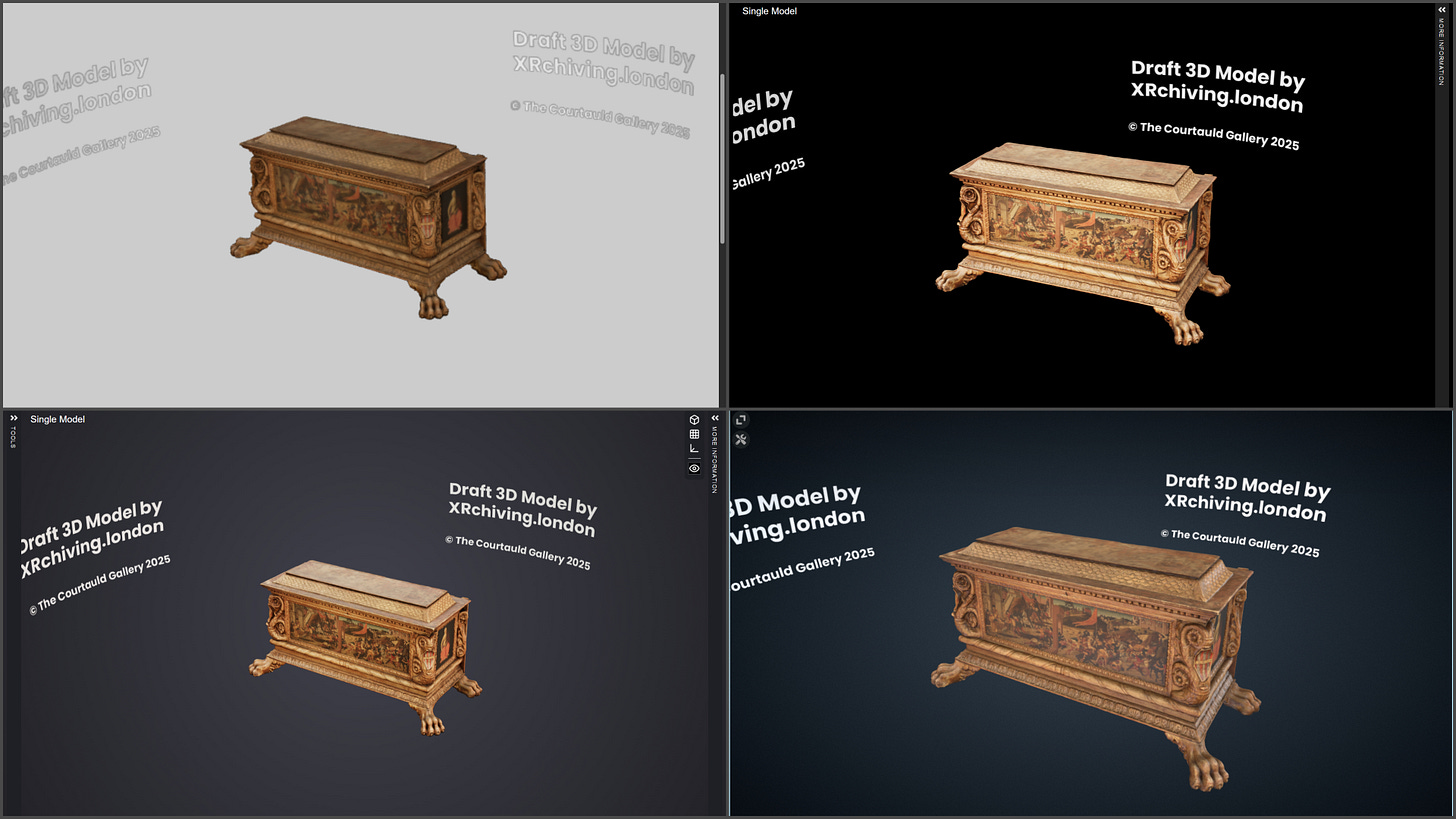Interoperable, Accessible, Portable 3D Data
The IIIF specification for 3D data has been publicly revealed, time to get to work!
For a video version of content presented in this article, check out this presentation I gave to the UK’s Chartered Institute for Archaeologists. Slides and notes here.
~ Tom
The 2025 IIIF Annual Conference and Showcase took place last week on the 2-5 of June in Leeds, UK, and one of the highlights for folks working in spatial heritage is no doubt the first official reveal of the framework’s WIP support for 3D.
What the heck is IIIF?
The International Image Interoperability Framework (triple-eye-eff) is a way for organisations to publish data online so that it can be more easily accessed, used, combined, and built upon. To this end, the work of the IIIF Consortium is lead by these goals:
Provide rich access to digitised data.
Define & maintain IIIF application programming interfaces (APIs).
Develop, cultivate, and document related viewing technologies.
There’s more to it than that, but as a practical demonstration of what we’re talking about, check out this link. To begin with, you are able to flip through pages of a 15th century manuscript that has been digitised and is now hosted online by Bibliothèque Virtuelle des Manuscrits Médiévaux: this zoomable viewing experience is powered by IIIF.
As you browse the pages, you might notice that the pages all have some sections missing, that’s because at some point in history some naught person chopped out the illustrations! 🥹 Don’t despair, though! The illustrations, which are held by Bibliothèque Nationale de France, have also digitised and also made available via IIIF. At the check of a checkbox, you are able to digitally reunite the illustrations with the manuscript. Phew! 😌
It’s not just the media that has been published via IIIF, information about the media and subject—metadata—has also been published. You can see this in action on this slightly more elaborate update to the manuscript experience, in which more details about the subject, data owners, attribution rights are viewable.

Behind the scenes, something like this is going on: image and metadata hosted on some properly configured servers are requested by APIs; how the data is to be combined is stored in a text file manifest (for the techies, it’s a .json file); the manifest is read by another API and interpreted by a compatible web viewer which then shows us, the end user, the interactive result.
Experiences like this are made possible by folks working together:
Organisations publish openly accessible data online.
IIIF provides the digital ‘plumbing’.
Developers build viewers and interactive experiences using the data and IIIF.
IIIF has long supported 2D media, fairly recently began supporting time based media (audio & video), and—you guessed it—is getting verrry close to supporting spatial (3D) media, too.
Why is interoperability important?
To quote IIIF themselves:
Many of the images and audio/visual resources that are fundamental to research exist in silos, with access restricted to locally-built applications. IIIF gives you and your audience freedom to work across barriers.
The same is true for 3D resources. An essential goal of publishing 3D heritage data via the IIIF framework is to make it accessible, not only to researchers but also wider online audiences.
Either directly or indirectly, by improving accessibility via interoperability GLAM organisations also support other important initiatives such as open access (generally speaking, data can’t be interoperable unless it is open), better understanding of copyright, and data portability.
The latter is especially important in the context of the GLAM sectors historical approach to online 3D data hosting and display, namely an over-reliance on 3rd party (and often commercial) platforms. Not only is the technology important in this regard: championing the cause is also a key component to ensuring that heritage 3D data doe snot become locked in to closed systems.
To this end, in November 2024, the IIIF Community Group organised a special group call with Epic Games to discuss the concerns and hopes that the spatial heritage community hold with regards to cultural 3D data hosted on sketchfab.com
The IIIF 3D Community & Technical Specification Groups
3D related IIIF endeavours are lead by two groups: the 3D Community Group (CG) and the 3D Technical Specification Group (TSG).
The CG is host to 400+ members on Slack and provides a space to share work & ideas about applications of spatial tech to the gallery, library, archive, and museums (GLAM) sector, as well as discuss challenges & opportunities for interoperability in the sector. Among other things, the CG was instrumental in establishing user stories for interoperable 3D to focus initial development of the IIIF 3D specification.
The TSG is a smaller group, mainly comprised of core developers working on updating the IIIF specification to support 3D. The TSG is currently lead by folks from Duke University, The Smithsonian Institution, the Web 3D Consortium, the TIB – Leibniz Information Centre for Science and Technology.
The work of both the CG and the TSG aim to empower GLAM organisations to publish 3D data alongside rich metadata (information about the subject that has been digitised in 3D, about the 3D data files themselves, about the digitisation process)

What’s New in IIIF 3D?
The activity around interoperable 3D data is really heating up and at the IIIF conference in Leeds, members of the CG and TSG presented a ‘soft launch’ of 3D support in the IIIF Presentation API during the conference opening plenary session.
While the official specification update release is slated for January 2026, it is now possible to tinker with some nascent IIIF 3D. Between now and the launch proper, then, is a great opportunity for heritage folks working with 3D and those already supporting IIIF at their organisation to get involved developing, building, and imagining what IIIF 3D can do in the future.
Here are some other 3D related videos of presentations and workshops from the conference to give you an idea of what people are working on and thinking about:
The full conference video playlist is a great introduction to IIIF and sample of the exciting work being carried out using the framework worldwide.
Demos, demos, demos
Here are some examples of live IIIF 3D projects and demos:
XRchiving / The Courtauld Gallery
A digitisation project I am involved in myself as part of XRchiving, this example demonstrates simply the display of a 3D scan of a 15th century Italian ‘cassone’, or marriage chest, in various 3D viewers. A static 3D file is referenced in this .json manifest, which is read and interpreted by the different 3D viewers hosted elsewhere:
Morphorsource.org
Morphosource.org is a 3D data repository hosted by Duke University and their team have developed—as far as I know—the broadest and most robust support for IIIF 3D thus far. All data on MorphoSource now have previews backed by IIIF4 manifests which means each listing of 3D data on the platform now has an associated IIIF 3D manifest available e.g. this listing for a 3D model of a Elliptic Hyperboloid, String Modell, now has a IIIF 3D manifest available here.
Users with data on MorphoSource can now save comment label annotations on 3D models, where the comment labels automatically display on the media page for all users, and this is also backed by IIIF4. Here is an annotated fossil skeleton and the IIIF manifest including the comment annotations is here.
Relatedly, the Morphosource team has done the whole GLAM sector a favour by publishing a tool that allows you to export annotation data from Sketchfab hosted 3D models. This is a real boon as annotation data that was added to a model via sketchfab.com’s 3D editor has previously been very difficult to export and reuse.
Find out more about Morphosource’s support for IIIF 3D on the here or follow along with their conference workshop using this documentation.
The Smithsonian Institution
The Smithsonian Institution (which has a very well developed 3D digitisation programme) has published a landing page demonstrating its support for the upcoming IIIF 3D support in their Voyager 3D viewer.
Kompakkt
The Kompakkt Consortium (a joint venture from the Department of Digital Humanities University of Cologne & Open Science Lab TIB – Leibniz Information Centre for Science and Technology), developers of the Kompakkt 3D platform have set up a similar page demonstrating the loading of IIIF 3D manifests in their 3D viewer. The code for this demo can be found on GitHub.
British Library Labs
The clever folks at the have been looking into building a IIIF 3D importer for the Godot open source game engine.
Anaverse
Artist-led generative art project anaver.se already has basic support for import of IIIF-enabled 2D and 3D assets.
Vision Pro Demo
Staff from Yale Library cooked up this prototype of a IIIF scene editor running on Apple’s Vision Pro.
Try it yourself
If you’re keen to experience IIIF 3D yourself, you can grab a link to an existing manifest e.g.:
And paste it into one of these tools to generate links to view the 3D model in a variety of 3D viewers:
Next Steps, An Invitation
This is just the beginning for IIIF 3D, and we need your help! If you’re interested in topics covered in this article I encourage you to:
Join the IIIF 3D Community Group.
If your organisation creates 3D data, try creating some IIIF manifests for your data (you could use this handy guide).
If you are a developer, please consider contributing to IIIF 3D on GitHub.
Everyone else can contribute to development by testing current implementations and reporting any and all bugs and quirks.
Explore more IIIF 3D presentations here.
















